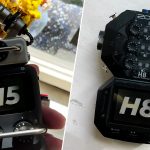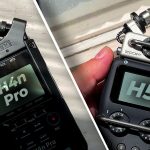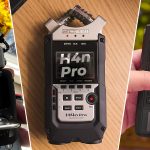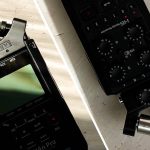In this review, we’re going to compare two recorders at the opposite end of the spectrum, the Zoom H4n Pro, and the Zoom H8. We’ll have a look at what each recorder can do well, what they can’t do, and we’ll discuss one major flaw that the Zoom H4n Pro has.
Let’s get started.

Inputs
First off, let’s see how many inputs each recorder has. This refers to the number of microphones, or instruments, which can be plugged into these recorders.
The inputs are not to be confused with the Zoom capsules, which are indeed different, but don’t worry, we’ll go into detail on those in a bit.
So the Zoom H4n Pro has exactly two XLR/TRS inputs, while the Zoom H8 has six. They also both have a 3.5mm mini-input jack, but in different places.
On the Zoom H4n Pro, the 3.5mm input is on its back, and it’s built into the body of the device. On the Zoom H8, it’s part of the default X/Y capsule. Bear in mind that not all Zoom capsules have this input, so by swapping capsules on the H8, you might temporarily lose this input.
So the most obvious use for a 3.5mm input is that you can plug a radio mic into it. If the mic needs plug-in power, both devices can provide it.
A radio mic can be clipped to your collar, and it is usually used in films, interviews, and sometimes also for content creation, like here on YouTube.
XLR Inputs
Now, let’s get back to the XLR/TRS inputs. So these inputs are for larger microphones, such as the Shure SM7b, which is what I’m using right now. This microphone is generally used for podcasts, and voice work.
They can also take other types of microphones, such as shotgun microphones, which are a lot more focused, or directional, and they are used to isolate sounds. This is particularly useful when recording sound effects, instruments, or dialogue.
These types of microphones are very good at recording what’s in front of them, and largely ignoring sounds coming from the back, or the sides. The SM7B does that as well, to a certain degree, but a shotgun mic, such as the Rode NTG-2 for example, is specifically designed for that purpose.
If a Shure SM7B is a flashlight, a shotgun mic is more like a laser.
If you want to check out my current recording setup in its entirety, I actually have a link down below, where you can view it.
So, to finish on the XLR inputs, how many do you need exactly? If you want to use the recorder as it is, and you just want to explore, and record sound effects, concerts, ambiences, etc. then all you really need is the H4n Pro.
If your recording needs involve more than two microphones, such as when you might record an interview, some instruments, a podcast, or sound effects, the Zoom H8 would be far more suitable, due to the increased number of inputs.
The Zoom H8 can actually take in more than 6 mics, but we’ll go into that a bit later on in the review.
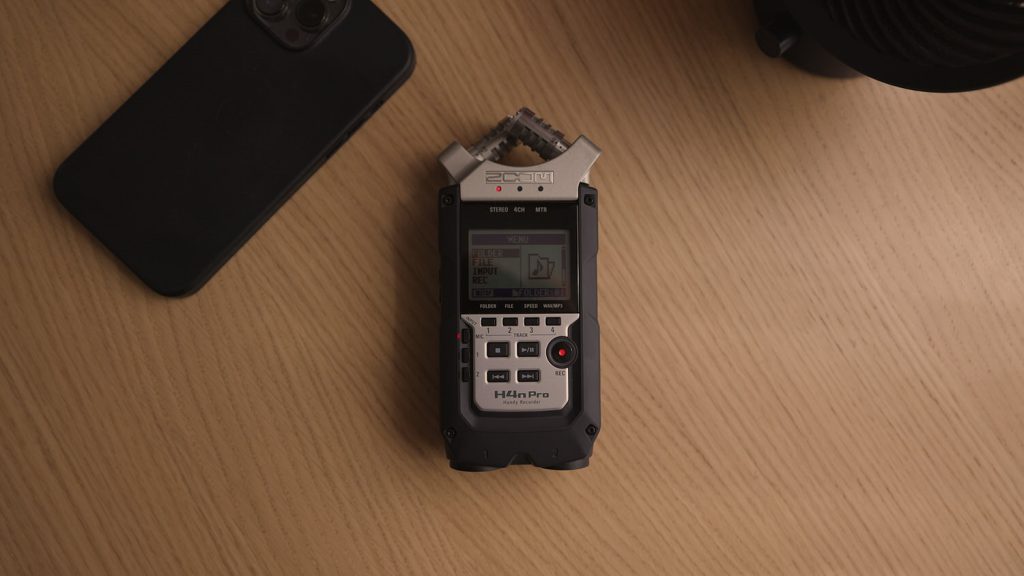
Battery Life
Next up, what about battery life. If you’re going to take these recorders out and about, how much use will you get out of them, before the battery runs out of juice?
According to Zoom, the H4n Pro is rated for about 6 hours, and the H8 is rated for around 10 hours. Bear in mind that manufacturer estimates tend to be rather optimistic, as they are usually tested under ideal conditions.
My own tests yielded times that are close to that, but it really depends on what you’re doing. Are you using Phantom Power? How many mics do you have connected? Are you constantly turning the screen backlight on? What kind of batteries are you using? Which brand? What is the air temperature?
Practically speaking, you should always carry a few more batteries with you, just to be safe. Even so, you’re unlikely to ever swap batteries during a session, as 6-10 hours is more than enough for most uses.
These types of recorders also work with power banks, so that’s usually also an option, or alternatively, you can purchase an accessory pack for the Zoom H4n Pro, which will have an adaptor and charging cable.
This will allow you to plug your device into the mains, and thus not have to worry about recording time, until your SD card gets full, that is.
If you do want to check out those accessory packs, I’ve got affiliate links down below for each.
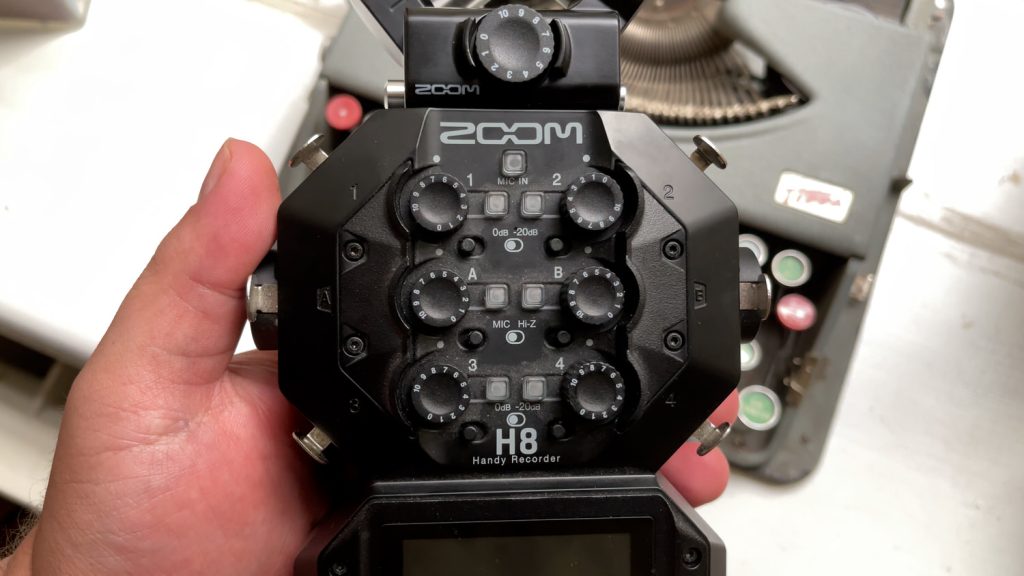
Size & Build
When it comes to build quality, they are equivalent. Usually, when comparing devices, I have a preference one way or another for the feel of the body, but in this particular case, they’re about even.
There is a known issue that these devices have though, which I have to draw your attention to. Due to the rubberised nature of the bodies, they can become sticky to the touch a few years in.
This isn’t guaranteed to happen, but it can. There are ways in which this can be fixed, but I’d rather not link you to them, as there is a chance that some might damage your device.
This isn’t a problem with Zoom devices specifically, but an issue that arises with devices that have this type of rubberised coating.
By the way, this isn’t the issue that I was alluding to at the start of the video. Stick around until the end to learn about that one.
In terms of size, the H4n Pro measures 73 x 157.2 x 37mm, or 2.87 x 6.19 x 1.46 inches, and weighs in at around 294g, or 10.37 oz. The H8 however measures 116.4 × 163.3 × 48.6 mm, or 4.58 x 6.43 x 1.91 inches, and weighs in at around 354g, or 12.49oz.
Affordability
What about affordability? While prices do fluctuate, as you would expect, the H8 is more expensive than the Zoom H4n Pro. These devices can cost different amounts in different countries, so I’ve actually included affiliate links down below, if you want to see how much they cost in your country.
Display
When it comes to display, these devices are very different. The H4n Pro has a backlit screen. Nothing particularly impressive, but it does the job. It shows you what you’re doing, and it can be lit up in low-light conditions.
The screen on the H8 is much nicer, and touch-sensitive, which allows you to operate its functions without the constant use of buttons and knobs.
Versatility
Next up, let’s talk about just how versatile these recording devices are, and which would be more useful to you personally.
So obviously, the H4n Pro has fewer inputs. Not only that, but it can not use any of the myriads of capsules available to the H8. Its advantage is one of size, and portability.
The H4n Pro is one unit, so you can easily just throw it in your bag, and head out to record. Whether you want to capture sound effects, live concerts, ambiences, or individual instruments, this device offers you speed. Kind of. It does have a flaw when it comes to speed actually, but we’ll discuss this a bit later in the video.
The other alternative is of course the H8, which not only has more inputs, six, to be precise, but it can also utilise all of the Zoom capsules available.
Given its larger size, it’s not quite as portable as the H4n Pro, and it can be made less so by a certain capsule, which we will discuss in a bit.
Actually, since we’ve breached the topic of capsules, let’s talk about them.
Capsules
Now, we know that the Zoom H4n Pro can not use any capsules, just its built-in X/Y mics. The Zoom H8 can use any of the capsules though, and it allows you to easily mount and unmount them.
Now, whenever I make a Zoom handheld recorder review, I end up talking about each capsule, and after doing it over and over for multiple videos, I realise that that’s not a very efficient use of either of our time.
So, what I’ve done is I’ve put together a playlist, and made a short video for each capsule.
If you check out this playlist, you’ll see that it covers not only all of the Zoom capsules, in a short format, but it also covers other very useful information about Zoom recorders, such as which sample rates to use, what bit rate, which file types, how to set your levels, so that you don’t ruin your recordings, and more.
In case you want to learn all of that, you can check the playlist on my YouTube channel, so you can learn all this useful information, that will help you level up, in the shortest amount of time.
If you don’t already know which capsules are available, I really recommend watching that next, as some of them, like the EXH-6, might really surprise you.
Voice Overs
So now, let’s discuss voice overs. During my time travelling, I needed a recording setup which was not only effective, but portable. It needed to take up as little space as possible, without sacrificing my audio quality, as I was using it for my YouTube channel.
My problem was this: I’d stay in different Airbnbs for different amounts of time. Each location would have its own acoustic properties. Some apartments were very echoy, some had traffic noise coming from outside, some had neighbours with dogs that would occasionally start barking.
I needed a solution that could address all of these issues. What I landed on was using a Zoom H6, with the Zoom SGH-6. All I had to do was place the device on a small desk stand, point it towards my mouth, and press record.
Capsules
So, why the SGH-6 capsule? If you’ve watched the playlist I mentioned earlier, you’ll know that the SGH-6 is highly directional. In other words, it’s designed to pick up mostly sound coming from in front of it, whilst mostly ignoring sounds coming from the back, or the sides.
This is incredibly useful if you want laser focus, or close to it, when recording audio. By using this setup, a lot of the noise that was around me was significantly diminished. It didn’t go away completely, but it allowed me to record far cleaner voice overs in basically any environment.
I could have used the default X/Y capsule that comes with the H6, or any of the H series Zoom recorders, but that setup would have invariably captured a lot of the sounds around me, including the sound of my voice reverberating off the walls.
I could have also used the SSH-6 capsule, but that can do a lot more than the SGH-6, and it would have been a bit wasteful, given my needs.
Again, playlist down below if you want to learn more about the kind of value that each capsule can bring into your life.
Also, as a side note, the H5, and H8 would have also worked, but the H6 has a more compact form factor, so I ended up going with it instead.
By the way, I’ve reviewed a lot of the Zoom H series recorders on my YouTube channel. I’m also starting to review Tascam recorders.
Audio Interface
Can you use either of these devices as an audio interface? Yes. Both the H4n Pro and H8 work as an audio interface.
The process is slightly different for each, but you just have to go in the Menu, and look for the option.
Free Sound Effects
By the way, did you know I have compiled the largest list of free sound effects in the world? Over 500GB of sounds, ready to be downloaded, free of charge. Just figured you’d want to know. And now, back to the review.
Sound Quality
So what about sound quality? Both the Zoom H4n Pro and Zoom H8 sound basically the same. They’re both suited to record voice, music, concerts, sound effects, instruments, and basically anything else that you might need.
Bear in mind that the H8 is far more versatile, due to the fact that it can use many different capsules, all of which have been designed for different purposes.
For example, you can use the built-in mics on the Zoom H4n Pro to record your voice, but you’ll also capture a lot of the room that you’re in. This applies to not just noises coming from the room, but also the sound of your voice reverberating off the walls.
Versatility
A capsule like the SGH-6, in combination with the H8, would do a lot better job of recording your voice, as the capsule is far more focused, and so it will capture more of your voice, and less of your surroundings.
There are of course situations where capturing the feel of the room is more desirable, but when it comes to voice-overs, most of the time you’ll want to isolate your voice as much as possible.
Now, even though these two devices are very handy, there is one use for which they are not quite as suited. When it comes to recording super quiet stuff, like ASMR, or quiet natural ambiences, they’re not as good as the Sony PCM-D100.
To be fair, no other handheld recording device really comes close to it, so this isn’t just the case with Zoom.
Super Quiet
So why are they not quite as suited for this purpose? When it comes to any recording device, including the Sony PCM-D100, the internal components of the recorder will produce a certain amount of hiss. This hiss is present in all recordings, but it’s way more noticeable when the recording is quiet.
When you increase the gain, what you want to record becomes louder, but so does the hiss. What you want to achieve is a good noise-to-sound ratio.
Basically, you want more of the sound that you want to record, and less of the hiss as a result. The problem is that there is a physical limit to how close you can get to your sound source.
As a result, you want a device with as little self-noise as possible. The PCM-D100 is by far the best.
The problem is that it’s currently not easy to get a hold of, and as a result, prices have skyrocketed. If you want to check out how much it costs in your country, I have an affiliate link down below, where you can check.
To be clear, the Sony PCM-D100 also has self-noise, but it has less than any other handheld device. You just need to pay for that perk.
I’ve actually recorded some of my sound effects libraries with this device. If you want to check them out, I’m actually doing a sale until the end of this year. Link down below if you’re interested.
I’ve also reviewed the PCM-D100 on my YouTube channel.

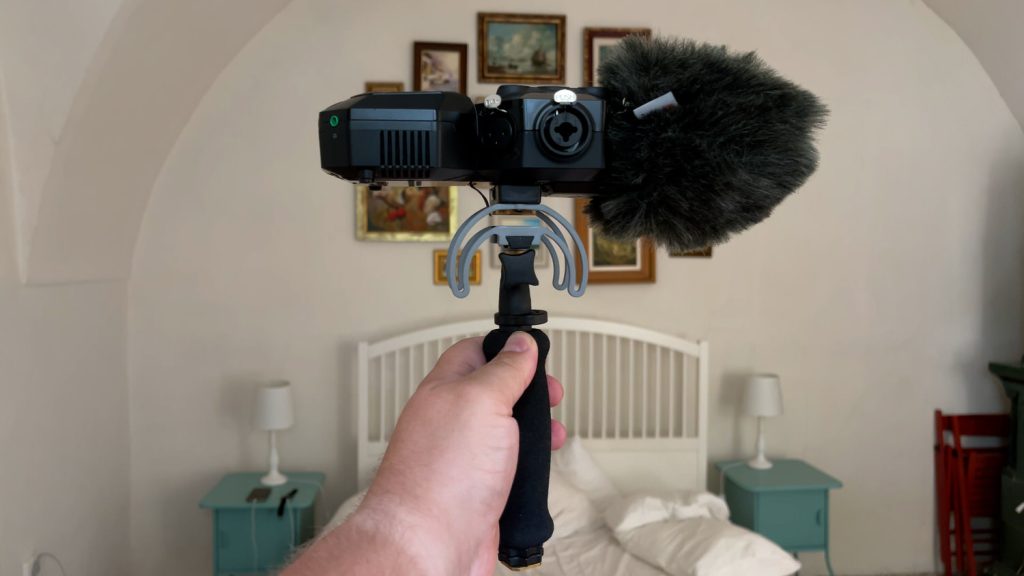
Wind Protection
Now, if you’re looking to purchase a device like this, you probably intend to record outdoors.
When doing so, you’ll often find yourself battling wind noise. This can happen if you’re recording interviews outside, if you’re recording natural ambiences, or maybe even outdoor music performances.
Most recorders come with a little foam windshield, which is basically useless. What you need is a proper windshield, which will eliminate most wind, thus protecting your recordings.
I always recommend this kit from Rycote, as it offers you not only a quality shield, but also a grip, and a shock mount, which allows you to hold the recorder, without introducing handling noise into your recordings.
Also, bear in mind that any windshield will have its limitations. Really strong wind can cause problems, so bear that in mind. If it’s a bit windy, there won’t be a problem, but if there’s a proper storm going on, you’ll have to get creative with recorder positioning.
Portability
Next up, let’s talk portability. Obviously, one of the perks of a handheld recorder is that it can just be thrown in your bag, and you can head out to record.
If I had to pick for portability alone between these two, I’d go for the H4n Pro. Even though the H8 can use all of these capsules, depending on which one you’re using, your choice of capsule might actually make it kind of awkward to carry around, at least without disconnecting the capsule first.
If all you need is the X/Y mics that come by default with these recorders, then you can just grab the H4n Pro, throw it in your bag, and you’re ready to go.
Guitar Effects
What about guitar effects? Surprisingly, both of these recorders have them. I’m not going to go into too much detail about each, but know that they are vailable.
Ease of use
So what about ease of use? Can you easily use the H8, and the H4n Pro?
In my personal experience, the H8 would be easier to use. The reason is that it has physical knobs for the gain, as opposed to the H4n Pro, where you’d have to adjust it using a button on the side of the recorder.
Storage
When it comes to storage, the Zoom H4n Pro can take SD cards of up to 32GB, while the Zoom H8 can work with SD cards up to 512GB.
Even if you’re recording at 24bit/96kHJz, a 32GB SD card will give you a lot of space to work with. If you record a stereo track at 24bit/48kHz, in theory, 32GB should allow you to record for 2000 minutes, which is equivalent to 33 hours.
With both devices, your battery will run out way before you can fill up the SD card. This is assuming you’re only recording one stereo track though.
Before we move on, at the start of the video I told you that the H4n Pro has a massive flaw. The issue has to do with its bootup time.
You see, the larger the SD card you have inside of it, the longer it takes for it to boot up. With a 32GB card, it can take up to a minute for the Zoom H4n Pro to actually start.
I’ve noticed that if I format the card inside of the device, the bootup time is shorter, but it will be present regardless. If you must use the H4n Pro, a smaller SD card will shorten the startup time.
This is not an issue with the other H series recorders, like the H5, H6, or the H8.
Conclusion
In conclusion, which one should you get? Let’s consider each recorder.
The H4n Pro is way more affordable, portable, and easy to use. You can just throw it in your bag, head out, and begin to record. The flaw mentioned earlier in the review might impede that, but still, it’s a good recording device.
You wouldn’t need to carry extra capsules with you, or anything like that. Maybe just some spare batteries.
If that’s all you need, then the Zoom H4n Pro is definitely a great choice.
If, on the other hand, you want the above, but you also want capsules, the ability to plug in way more mics, and the desire to be looked at it public, as you handle this lovely centipede-like recorder, then the H8 is for you. You also don’t have to deal with the issue that the H4n Pro has.
If the H4n Pro is not enough, but the H8 is too much, I’ve actually reviewed other handheld recording devices, you can check my playlist on my YouTube channel where you can find all of them.
If you’d like to purchase any of the items I’ve mentioned in this article, or see how much they cost in your country, I have a link down below where you can view them.
Thank you for reading my comparison review of the Zoom H4n Pro vs Zoom H8. I invite you to have a look at some of my other articles. We have something for everyone, whether you’re interested in audio, or cameras and lenses. Alternatively, if you prefer video reviews, feel free to have a look at my YouTube channel.
Product Links
Down below you will find all of the items I talked about in this article.
